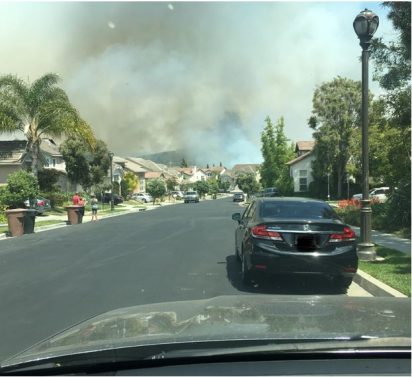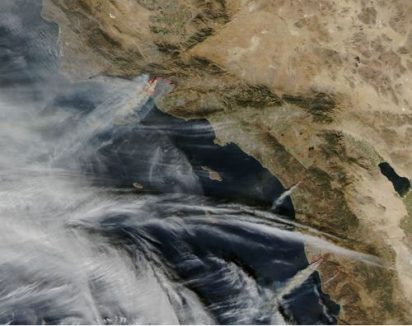It’s time to get fired up about wildfires
By Mackenzie Nelson

From the comfort of my window seat, I watched as the sea of clouds rapidly gave way to clear skies. It was the first sign I had officially left the Pacific Northwest and was flying over Northern California. Looking west, the ocean expanded before me as I mentally marked exactly where I was along the coast—Bodega Bay, Tomales Bay, etc.—checking off points confirming my journey south. The air so clear and the colors so vibrant, I sat back and enjoyed the lack of gray that surrounded me for the first time in months. It was December, and it had already snowed twice in Seattle.
My plane landed in San Francisco. I walked across the airport, boarded my second flight, and quickly descended into my final destination in Orange County. It wasn’t until I made it to my parents’ house that I realized I hadn’t seen any smoke from the fires I heard were raging through California. For weeks, I listened to and read news coverage of the Atlas, Tubbs, and Nuns fires in northern part of the state and the Thomas and Creek fires in the south. However, during my travels, all I noticed was the glimmering Pacific Ocean.

Growing up in Southern California, I had my fair share of experiences with wildfires. While some kids had snow days, I had fire days—weekdays when schools were closed because the smoke from the fires made the air quality so poor that we were advised against leaving our homes. Wildfires dominated the dry seasons of my childhood; I just took them to be a natural part of the life I was living in the “coastal desert” that is my hometown and its surrounding areas. However, I never had to face anything like the fires that occurred in this past year.
After experiencing a wetter-than-normal winter in the beginning of 2017, the lush, green California landscape served as the perfect location to host rampant and untamable wildfires—fueled by overgrown vegetation and propagated by the strong, westward blowing Santa Ana and Diablo winds. Exacerbated by a growing population that strains water resources, the hot and dry weather helped make 2017 the worst fire year California has ever seen. The Thomas Fire alone burned over 280,000 acres while the Tubbs Fire destroyed almost 6,000 structures making these two the largest and most destructive fires in California history.
In ecology classes, we learn that fires are a natural part of ecosystems. They are a way of hitting the “reset button”—clearing out the dead flora and fauna to make room for the strong and resilient. This is especially true of the chaparral biome, which is made up of shrubbery that covers most of the land to the west of the Coast Range and south of the Sierra Nevadas. Chaparral shrubs have developed strategies to survive fires including initiation of germination by fire, development of extensive underground root systems, and production of seeds with casings that protect the embryos from high temperatures. The quick and short of it: chaparral biomes like fires.

But while the fires raged on land, my view of the ocean from the plane looked pristine. Not a hint of smoke touched the salty air. It looked like the ocean was completely unaffected by the events of the terrestrial world. However, coastal fires do affect marine environments, although the research to quantify these effects is thin. I was able to find an article on an event in Indonesia where iron-rich smoke from a wildfire spread out over the ocean and fertilized the upper few meters of the water where photosynthesizing algae flourish. As a result, the increase of the nutrient in the water propagated a red tide, and the coral reefs surrounding the Mentawai Islands died from suffocation.
Recently, scientists from University of California, Santa Barbara abandoned their original plan for their research cruise in order to investigate the effect of California’s wildfires on the ocean waters and marine ecosystems in the Santa Barbara Channel. The goal of this research is to determine if plankton respond to different types and amounts of ash; specifically, this project is looking at the effects of ash from the Thomas fire on the nocturnal and diurnal behaviors of plankton in the water column. Research like this may provide important predictions about ecosystem-level effects as fires like those recently experienced in California become more common.
The reality of the situation is that these fires—like the ones that took center-stage this past year—are becoming the “new normal” in California. As the climate and the way people interact with the environment change, so will nature. And while it may look like the ocean is untouchable from my seat at thirty thousand feet, more research needs to be done to evaluate the impacts of wildfires on marine systems.